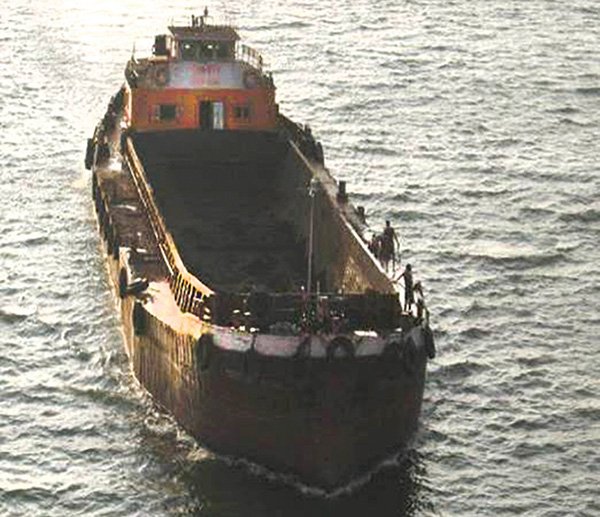Cargo
Significant amounts of cargo are being moved using IWT around the world. There are no limitations regarding the type of cargo which can be carried over IWT. In fact, the flexibility is greater – from built up fuselage of the Airbus A380 to refrigerated reefer containers & liquid Ammonia. Some comparative information is as follows:-
 • India @ 1% (plans to increase to 5% equivalent 25 billion tonne km by 2020) carried a total approximately 34.6 million tonnes in 2012 – 13 (mainly on NW -1, 2 & 3). This is miniscule compared to the potential. NW-2 alone has a potential of 50-100 million tonnes of coal to be carried over the next 20 years as per a study by IFCI). For this the fairways will have to be developed with reliable navigational aids, port & terminal facilities, connectivity with other modes of transport and ease of ingress and egress / accessibility.
• India @ 1% (plans to increase to 5% equivalent 25 billion tonne km by 2020) carried a total approximately 34.6 million tonnes in 2012 – 13 (mainly on NW -1, 2 & 3). This is miniscule compared to the potential. NW-2 alone has a potential of 50-100 million tonnes of coal to be carried over the next 20 years as per a study by IFCI). For this the fairways will have to be developed with reliable navigational aids, port & terminal facilities, connectivity with other modes of transport and ease of ingress and egress / accessibility.
• Over 32% (58 million tonnes) of Bangladesh cargo moves over IWT which also carried nearly 88 million passengers in 2010.
• Over a million people travel annually over China’s 125,000km of Inland Waterways using over 178,000 ships. According to a World Bank study, China’s commercial cargo handled on IWT is slated to increase from 1.6 billion tonnes in 2010 to 2.35 billion tonnes in 2020.
 • Germany @ 20% (191 million tonnes)
• Germany @ 20% (191 million tonnes)
• Netherlands @ 46%
• France @ 60 million tonnes / year
• Switzerland @ 5.5 million tonnes / year
• UK @ 41.4 million tonnes / year
• USA @ 630 million tonnes / year
IWT as a part of the Logistics Chain
For IWT to be effective and efficient, it is necessary for this mode to be integrated with the other transport modes in the supply chain. This will enable seamless movement of goods and people. Farm produce and perishables from the hinterland can easily travel up the cold chain to consumption centres, if this integration of land and water transport modes are integrated to facilitate transfer of refrigerated containers (reefers) from trucks to barges. Interconnectivity is critical. The FAIDA study done by CII and McKinsey some years ago showed the wastages and damages in transit caused by road transportation, transhipment and storage to be as high as 35% for perishables. IWT can effectively address this problem with a smooth, secure & congestion free movement.
Inland Navigation in India
India had vibrant inland water transportation till earlier this century and IWT was a viable mode of freight transportation. Regular steamers were operating on the Ganges from Kolkata to Allahabad and then on the Yamuna from Delhi to Agra and beyond. The Ganges, Brahmaputra, Kerala back-waters and canals in the West Coast and the Buckingham Canal along the East Coast were all effective marine highways. The country has about 14,500km of navigable waterways which comprises rivers, canals, backwaters, creeks, etc. Only 3,700km of major rivers is navigable by mechanised crafts but the length actually utilised is only 2,000km. As regards canals, out of 4,300km of navigation canals, only 900km is suitable for navigation by mechanised crafts.
The back¬waters and lagoons in Kerala and the Buckingham Canal of Andhra Pradesh and Tamil Nadu have great potential for use as a cost effective transport route. Uttar Pradesh has the highest length of navigable inland waterways (2,441km or 17.01%) of the country.
The need for developing IWT of course, had been activated by the setting up of the Inland Waterways Authority of India (IWAI) under the Ministry of Shipping. National waterways were identified and created and some plans started to be implemented particularly in the stretch of NW-1 between Haldia and Farakka. Fortunately IWT is now receiving a great fillip and appreciable resources (an estimated INR 1500cr in the 12th FY Plan), both time and money, are being allocated to this mode. India seems to have developed the required political will.
It has recently been announced that IWAI intends to apply for financing in the amount of USD 300 million equivalent (INR 1800cr) from the World Bank towards the cost of the capacity augmentation of national waterway NW-1 (Jal Marg Vikas).
Coastal waterways control should be moved into the jurisdiction of IWAI to facilitate seamless integration/ interface between ocean & river cargo movement.
Sanjaya Varma Advisor Urban Transport Planning Fairwood Green Transport
 TrafficInfraTech Magazine Linking People Places & Progress
TrafficInfraTech Magazine Linking People Places & Progress



